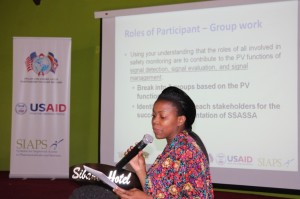
Adverse drug events among patients beginning new medicines can have disastrous consequences for treatment outcomes. The Swaziland Ministry of Health’s (MoH) National Pharmacovigilance Centre, the National Tuberculosis Control Programme, and the Swaziland National AIDS partnered with the US Agency for International Development (USAID)-funded Systems for Improved Access to Pharmaceuticals and Services (SIAPS) to launch an HIV/TB active surveillance system on May 8, 2013. The USAID-funded SIAPS program played a lead role in conceptualizing the surveillance system, mapping out the processes and facilities and developing the protocols and tools.
The newly established Sentinel Site-based Active Surveillance System for Anti-retroviral and Anti-TB (SSASSA) will monitor the safety of antiretrovirals and anti-TB medicines throughout the country. In the longer term, a comprehensive surveillance system will be scaled up to cover all medicines in Swaziland to ensure their acceptability and appropriate use to prevent harmful outcomes.
Dr. Vusi Magagula, Deputy Director of Health Services from the Swaziland Ministry of Health, was joined by Ms. Khosi Mthethwa, Health Systems Advisor at WHO, Ms. Lucille Bonaventure, PEPFAR Country Coordinator and SIAPS Country Project Director Kidwell Matshotyana. Each speaker emphasized the importance of an active surveillance system and its significant impact on the regulatory authority’s decision making and risk management planning.
The SSASSA database, an electronic tool developed specifically for the active surveillance, was installed at six selected sentinel sites. The data collected at each of the sites will be sent to the coordinating center in the MoH Pharmacovigilance Centre where the data will be cleaned, aggregated, and analyzed before dissemination to relevant stakeholders.
The active surveillance system developed and launched in Swaziland underscores the success of locally developed and sustainable pharmacovigilance systems that can be scaled up to meet the needs of both regulatory decision makers and health consumers.

